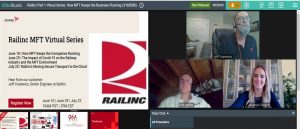A critical component of U.S. transportation infrastructure, Railinc supports commercial and government organizations with the information services they need to keep their rail assets moving day and night.
Axway and Railinc
In a three-part webinar series, Axway and Railinc share how Axway Managed File Transfer keeps the railroads and other industries running, 24/7.
Catch up on part one with the following recap, then register for Part 2: Move to the Cloud – The Impact of Covid-19 on the business!
A linchpin of rail traffic in North America
Railinc exchanges Axway SecureTransport-based data with around 800 different industry stakeholders. These interactions take the form of over 450,000 file transfers per day, a significant portion of which come from 250 daily high-volume customers.
The company’s Managed File Transfer (MFT) capabilities are a key product within its core services, including RailSight — a suite of applications that helps shippers, rail equipment owners, and transportation management providers to manage rail shipment and equipment data.
“If our MFT systems went offline unexpectedly, several areas within the rail network would begin to grind to a halt within a matter of hours,” said Jeff Yusiewicz, Senior Middleware Messaging Engineer at Railinc.

“To ensure this situation never comes about, it’s essential that we ensure maximum levels of availability for MFT. And because our customers’ appetites for digital solutions are growing all the time, it’s also vital that we can scale up our MFT capabilities to process 6 percent per year-on-year data growth.”
A highly available, scalable MFT solution
Yusiewicz explained that in the past, Railinc relied on a combination of legacy tooling and homegrown software to support their MFT requirements, which became increasingly difficult to manage and maintain as data volumes grew.
Federal information regulations and evolving security standards made it more pressing to meet clients’ requirements.
Railinc chose Axway’s SecureTransport for a central, secure, and easy-to-manage platform that delivers end-to-end control and visibility of its enterprise file transfer processes.
Reputation, performance, scalability, and cost were important factors in selecting the MFT solution.
SecureTransport’s high volume raw message feed systems now support 24/7 data exchange for millions of messages per day. File transfers play a key role in helping rail operators plan their routes, cross national borders, and track and trace their rail assets.
Before using SecureTransport, special customer needs were becoming a time-consuming undertaking. If a previous vendor system could not meet a customer’s need (specifications such as security, transfer methods, underlying software clients, etc.), Railinc teams would have to look at adding features to the in-house legacy system, and software upgrades could get costly.
“We are in the business of transportation, not developing file transfer products!” Yusiewicz added. “SecureTransport helped centralized the delivery of service and kept us up-to-date with industry changes and trends.”
Powering forward into the cloud
Building on its success with SecureTransport, Railinc is moving from an active/passive on-premises deployment hosted on-premise to a highly available configuration in an AWS private cloud.
“We are always looking for innovative ways to support our customers with new digital solutions, and our MFT volumes are growing steadily. This move to the cloud enables us to optimize our operational costs as we scale out our MFT environment,” said Yusiewicz.
Railinc is also exploring the possibility of augmenting the platform with operational intelligence capabilities from Axway. Adding enhanced reporting capabilities to SecureTransport could help identify and close down cyber threats more quickly, for example.

Up next: How Railinc stayed responsive through COVID’s unique challenges
Now that you’ve read the recap, dive deeper into Railinc’s current on-premise configuration and learn about how the company delivers 99.95% availability for mission-critical B2B file transfers, by watching the replay of part one here.
Coming up on June 29th is a discussion about how Railinc handled COVID-related challenges. There were interesting “up-ticks” and “down-ticks” within the system during this very demanding year.
Learn how they carefully monitored for changes in traffic patterns and how commodities and customers were impacted.
Register for Part 2 of this webinar: Move to the Cloud – The Impact of Covid-19 on the business.


